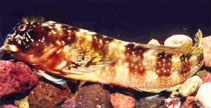| Family: |
Blenniidae (Combtooth blennies), subfamily: Salariinae |
| Max. size: |
8.54 cm SL (male/unsexed); 8.04 cm SL (female) |
| Environment: |
reef-associated; marine; depth range 0 - 1 m |
| Distribution: |
Southwest Atlantic: Trindade Island, Brazil. |
| Diagnosis: |
Dorsal spines (total): 11-12; Dorsal soft rays (total): 13-15; Anal spines: 2-2; Anal soft rays: 15-16. Diagnosis: This species is distinguished from its Atlantic congeners by its speckled body and head with small black spots (vs. absent in S. cristata); modally 14 segmented dorsal fin rays (vs. 15 of S. cristata from other Brazilian localities, S. caboverdiana, and
S. nuchifilis; and 16 in S. springeri); modally 16 segmented anal fin rays (vs. 17 of S. cristata from other Brazilian localities, S. caboverdiana, and S. nuchifilis; and 18 in S. springeri); modally 19 nuchal cirri (vs. 22 in S. cristata from other Brazilian localities, 5 in S. springeri, 6 in S. nuchifilis, and 17 in S. caboverdiana); and, modally 23 caudal vertebrae (vs. 24 in specimens of S. cristata
from other Brazilian localities, S. caboverdiana, and S. nuchifilis, and 25 in S. Springeri ). The means of counts of dorsal and anal rays are additional diagnostic characters.
Description: Segmented caudal fin rays, 8. Short lateral line, never extending beyond the first
segmented dorsal ray. Cirri present in anterior nasal opening, on top of eyes, and in the nuchal area (a longitudinal line of tentacles between the eyes and the origin of the first dorsal spine). The pelvic fin has the third segmented ray tightly joined to the second and separated only at their extremity by a thin membrane. The moderately elongate body has no scales. Mouth low on the head and horizontal, with maxilla reaching posteriorly to a vertical through the centre of eye (Ref. 49353). |
| Biology: |
Recorded from 0.1 to 1.0 meter depth inside tide pools and in the surf zone over crustose algae or volcanic reefs. Observed to be extremely tolerant to high salinity and temperature variations. Adults occur with other blennies (Ophioblennius cf. atlanticus and an undescribed species of the genus Entomacrodus, labrisomids (Labrisomus nuchipinnis and an undescribed species of Malacoctenus), the Trindade damselfish (Stegastes fuscus trindadensis), and a Brazilian wrasse (Thalassoma noronhanum) (Ref. 49353). Oviparous. Eggs are demersal and adhesive (Ref. 205), and are attached to the substrate via a filamentous, adhesive pad or pedestal (Ref. 94114). Larvae are planktonic, often found in shallow, coastal waters (Ref. 94114). |
| IUCN Red List Status: |
Vulnerable (VU); Date assessed: 23 March 2011 (D2) Ref. (130435)
|
| Threat to humans: |
harmless |
Source and more info: www.fishbase.org. For personal, classroom, and other internal use only. Not for publication.

